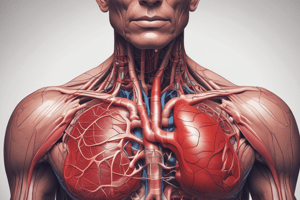Podcast
Questions and Answers
Which type of blood vessel carries oxygenated blood from the heart except the pulmonary artery?
Which type of blood vessel carries oxygenated blood from the heart except the pulmonary artery?
- Vein
- Venules
- Artery (correct)
- Capillary
What is the main function of the tunica media in blood vessels?
What is the main function of the tunica media in blood vessels?
- Prevent backflow of blood
- Regulate vessel diameter and blood flow (correct)
- Transport oxygen to the body cells
- Provide a smooth surface to reduce friction
Which protein is the most abundant in the human body and is found in the structural layers of arteries and veins?
Which protein is the most abundant in the human body and is found in the structural layers of arteries and veins?
- Hemoglobin
- Fibrinogen
- Collagen (correct)
- Myoglobin
What is the role of valves in veins?
What is the role of valves in veins?
Which layer of a vein is primarily composed of simple squamous epithelium?
Which layer of a vein is primarily composed of simple squamous epithelium?
Vasodilation refers to the:
Vasodilation refers to the:
What is the function of the smooth muscle layer in the tunica externa of blood vessels?
What is the function of the smooth muscle layer in the tunica externa of blood vessels?
In the clotting process, what is the role of fibrinogen?
In the clotting process, what is the role of fibrinogen?
What is the approximate composition of an adult's blood in terms of formed elements and fluid?
What is the approximate composition of an adult's blood in terms of formed elements and fluid?
Which vein is commonly found in the anticubital fossa?
Which vein is commonly found in the anticubital fossa?
What is the role of heparin in the body?
What is the role of heparin in the body?
What is the main purpose of disposing needles and lancets in puncture-proof containers in the laboratory?
What is the main purpose of disposing needles and lancets in puncture-proof containers in the laboratory?
Why is it important to familiarize and practice basic safety precautions in a laboratory setting?
Why is it important to familiarize and practice basic safety precautions in a laboratory setting?
What type of microorganisms are commonly present in clinical laboratory specimens?
What type of microorganisms are commonly present in clinical laboratory specimens?
What does OSHA stand for?
What does OSHA stand for?
Why should broken glass be handled with caution in a laboratory environment?
Why should broken glass be handled with caution in a laboratory environment?
Study Notes
Laboratory Safety and Personal Hygiene
- Numerous safety hazards are present in the lab, capable of producing serious injury or life-threatening disease
- Needles, lancets, and broken glass can transmit bloodborne pathogens
- Dispose of used needles and lancets in puncture-proof containers, properly labelled with disinfectant
- Hypochlorite solution is a disinfectant, used at 10% concentration
Blood Vessels Structural Layers
- Artery: bright red blood, tunica interna/intima, elastic, thick walls, no valves, pulse present
- Vein: dark red blood, tunica media, less elastic, thin walls, valves present, no pulse
Blood Vessels
- Artery: carries oxygenated blood from the heart, except pulmonary artery
- Vein: carries deoxygenated blood to the heart, except pulmonary vein
- Three layers of vein: tunica intima, tunica media, and tunica externa
Tunica Layers of Vein
- Tunica Intima: simple squamous endothelium
- Tunica Media: muscular tissue (smooth muscle), regulates diameter of lumen
- Tunica Externa: connective tissue, anchors blood vessels in place
Blood
- Blood removed from body: clot forms, fluid portion becomes serum
- Clotting process: prothrombin converts to thrombin, fibrinogen converts to fibrin
- Blood composition: 45% formed elements, 55% fluid (plasma with fibrinogen)
- Anticoagulant: heparin, a natural anticoagulant in the body
Blood Collection
- Anticubital fossa: median cubital vein, cephalic vein (lateral), basilic vein (medial)
- Blood collection tubes: red top (no anticoagulant), purple top (anticoagulant)
Circulatory System
- Pulmonary system: circulates blood through lungs, blood enriched with oxygen, removal of CO2
- Systemic system: provides oxygen and nutrients to different cells, removes waste
- Cardiac output: 20% of blood filtered by kidneys
- Smooth muscle: responsible for expansion and constriction of blood vessels
Blood Vessel Functions
- Vasodilation: expansion of blood vessels
- Vasoconstriction: constriction of blood vessels
Studying That Suits You
Use AI to generate personalized quizzes and flashcards to suit your learning preferences.
Description
Test your knowledge on the circulatory system with this quiz covering topics such as the pulmonary system, systemic system, and different types of epithelial linings. Practice identifying the functions and structures related to blood circulation in the body.




